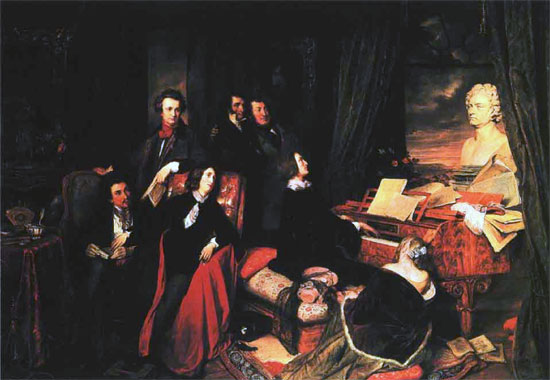|
|||||||||||
 |
|||||||||||
Articles - Liszt at the Piano |
|||||||||||
Liszt at the PianoEdward Swenson
Liszt at the Piano, Joseph Danhauser 1840 The painting Liszt am Klavier by Joseph Danhauser (oil on wood 119 x 167 cm) is in the Staatliches Museum Preußischer Kulturbesitz, Nationalgalerie in Berlin. The famous piano builder Conrad Graf is represented by the piano; his name is clearly legible on the nameboard. The artist's signature at the bottom left reads: Im Auftrag Conr. Graf's zur Erinnerung an Liszt, Joseph Danhauser 1840. [In commission from Conrad Graf in remembrance of Liszt, Joseph Danhauser, 1840]. Liszt performed two series of concerts in Vienna in spring of 1838 and the winter of 1839-1840 "on a splendid Graf piano." In the same year, Danhauser painted his Portrait des Klavierfabrikanten Konrad Graf. The portrait and genre painter Joseph Danhauser (1805-1845) had his studio in Graf's Mondscheinhaus near the Karlskirche in Vienna. The portrait depicts famous people from Liszt's circle of Parisian friends who are listening with rapt attention to his playing. They include the standing figures Victor Hugo, Niccolò Paganini, Gioachino Rossini and the seated figures Alexander Dumas père, George Sand, Franz Liszt, and Countess Marie d'Agoult. Because Graf commissioned the portrait, he probably also determined who should be depicted. Curiously the notable people assembled for the portrait were never together in Vienna at the same time. It is also strange that Graf omitted some other prestigious performers who were associated with his instruments including, Clara Wieck Schumann and Fryderyk Chopin. Both virtuosi used Graf pianos during their concerts in Vienna. Liszt at age twenty-nine is the only pianist in the group. He is playing a Graf fortepiano that has been tentatively identified by Deborah Wythe as Opus 2787. His glance is fixed on the bust of Beethoven, another of Graf's clients. Beethoven looms larger than life and seems to preside over the moment. All three musicians in the group have their eyes transfixed on him. The other four figures, each looking in different directions, appear lost in thought. Next to Liszt, seated on a cushion on the floor, is the Countess Marie Catherine d'Agoult (1805-1876), who wrote under the penname Daniel Stern. Her head is resting on the piano as she listens to the playing of her beloved Liszt. D'Agoult had a salon in Paris where famous musicians performed. It was there that she met and became involved with Liszt. She gave up her marriage and became Liszt's paramour. Living together in Switzerland, they had three children, including Cosima who later became the wife of composer Richard Wagner. A contemporary biography reported that Countess d'Agoult kneeled in rapture at the piano whenever the master played. The other three writers in the group, Alexander Dumas, pre (1802-1870), Victor Hugo (1802-1885) and George Sand (1804-1876) form a triangle of literati. George Sand, the penname of the French novelist and feminist Amandine-Lucile-Aurore Dupin, later Baroness Dudevant (1804 -1876), is characteristically dressed in drag and smoking a cigar. Her right hand rests on Dumas's closed book and her left leg rests on a thick book that is closed with a clasp. Symbolically her pose and fixed attention on Liszt seems to suggest, when such music sounds, words must remain silent. Sand, one of the most famous writers of the period, kept a salon in Paris and had love affairs with both Liszt and Chopin. Alexander Dumas reached the height of his fame after 1840 with his novels The Count of Monte Cristo and The Three Musketeers. Two other standing figures, the Italian composer and virtuoso violinist Niccolò Paganini (1782-1840) and the famous opera composer Gioachino Rossini (1792-1868) dominate the middle of the portrait in the background. Rossini may have met Graf in Vienna in 1822 when the Italian composer visited with Beethoven. A painting on the wall depicts Lord Byron (1788-1824), a literary model for young European writers. The statue on the far left represents Joan of Arc (1412-1431). Why Graf recommended this specific group for depiction with one of his pianos is not entirely clear. As the most famous and successful piano builder of the period he included his signed piano as the centerpiece in a circle of friends, famous poets, composers and virtuosi. Graf traveled to Paris in 1837. Specific details about his visit are still not known. |
|
||||||||||
|
© Copyright 2008 Edward E. Swenson, MozartPiano.com |
|||||||||||



 中文
中文